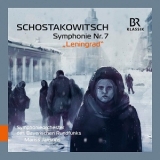 Dmitri Shostakovich: Symphonie Nr. 7 (Leningrader); Symphonieorchester des Bayerischen Rundfunks, Mariss Jansons; 1 CD BR Klassik 900184; Aufnahme 02/2016, Veröffentlichung 09/2019 (73') - Rezension von Remy Franck
Dmitri Shostakovich: Symphonie Nr. 7 (Leningrader); Symphonieorchester des Bayerischen Rundfunks, Mariss Jansons; 1 CD BR Klassik 900184; Aufnahme 02/2016, Veröffentlichung 09/2019 (73') - Rezension von Remy Franck
Nach Aufnahmen der Leningrader Symphonie mit den St. Petersburger Philharmonikern und dem Royal Concertgebouw Orchestra legt Mariss Jansons nun seine dritte Aufnahme der Symphonie vor. Sie ist vor allem gegenüber der ersten orchestral viel besser gelungen. Das Symphonieorchester des Bayerischen Rundfunks erlaubt ihm eine Detailarbeit, die dem Hörer ungemein viel zu hören gibt.
Für Mariss Jansons ist Shostakovichs 7. Symphonie weniger eine Symphonie, die etwas mit den Kriegshandlungen in und um St.-Petersburg zu tun hat, als vor allem eine tragische Symphonie mit vielen inneren Konflikten, mit Angst und Trauer, aber auch mit Auflehnung und Anprangern von Krieg und Diktatur.
Den ersten Satz gestaltet er relativ leicht und beschwingt, als sei das Kriegerische nur ein Spiel. Zentralstück der Symphonie sind die Sätze 2 und 3, als Erinnerung und als Nachdenken, wie es der Dirigent in einer Probe formulierte. Der vierte Satz erst ist ihm zufolge der Kampf, den er sehr dramatisch und laut gestaltet, aber nicht im Jubel enden lässt. Jansons reduziert ihn auf pure Dramatik und vermittelt so jede Menge ungute Gefühle.
Following recordings of the Leningrad Symphony with the St. Petersburg Philharmonic and the Royal Concertgebouw Orchestra, Mariss Jansons now presents his third recording of the symphony. In terms of orchestral playing it is much better than the first one. The Bavarian Radio Symphony Orchestra is rich in details that give the listener a lot to hear.
For Mariss Jansons, Shostakovich’s 7th Symphony is less a symphony that has something to do with the war in and around St. Petersburg than a tragic symphony with many inner conflicts, with fear and grief, but also with revolt and denunciation of war and dictatorship.
The first movement is relatively light and lively, as if the whole situation were only a game. The central pieces of the symphony are movements 2 and 3, as memory and reflection, as the conductor said it in a rehearsal. The fourth movement, according to him, is the fight. In this performance it is very dramatic and loud, but does not end in jubilation. Jansons reduces it to pure drama and thus conveys many unpleasant feelings.






















